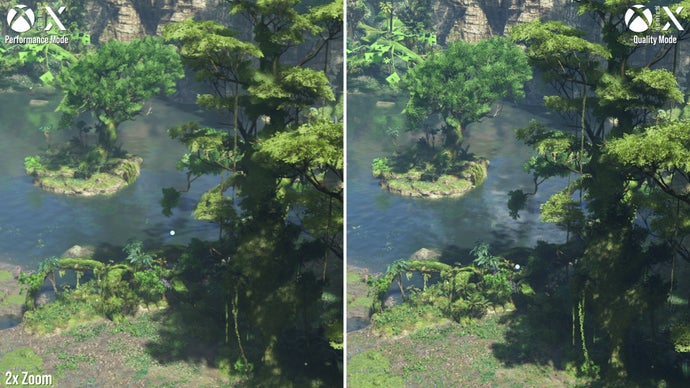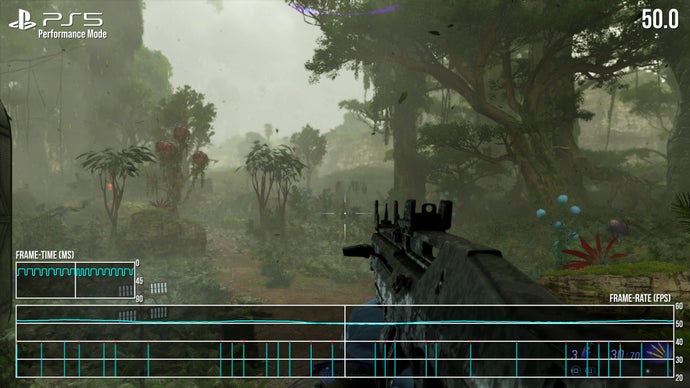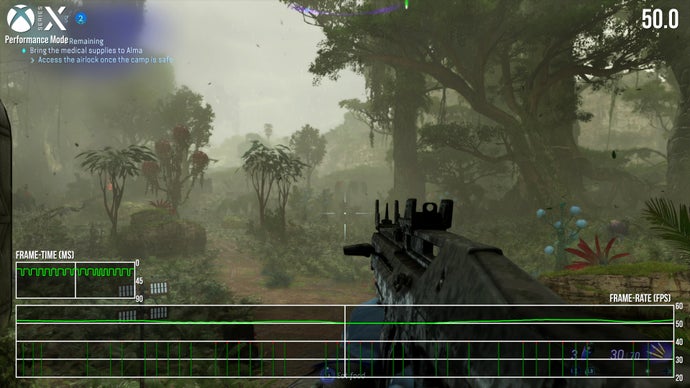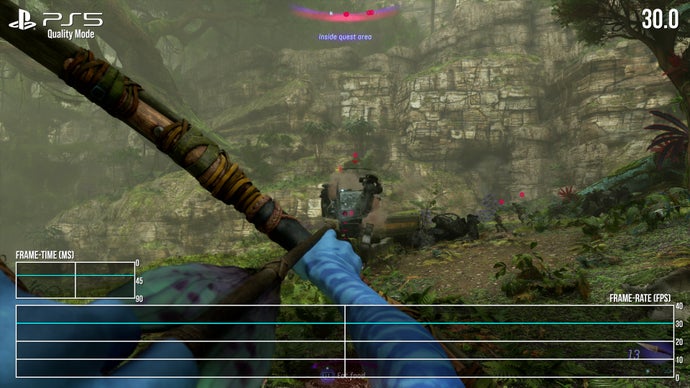Ubisoft Massive has surpassed itself with its work on Avatar: Frontiers of Pandora – a game that harnesses the power of PlayStation 5, Xbox Series X and S, to create one of the most visually striking games of the generation so far. Following on from Alex’s Avatar PC tech showcase, this write-up focuses on how the game compares on console: PlayStation 5, Xbox Series X and Series S.
The questions going in to Avatar are simple: between the dense, rich jungle environments, ray-traced GI and reflections, and high-quality materials, how does each platform hold up – particularly the less powerful Series S? And in looking at the game’s 60fps performance mode available only on Series X and PS5, are all of its cutting-edge visuals possible with unwavering performance? Or is the alternative 30fps quality mode the better way to go?
First things first: I’m happy to confirm you do not need a top-end PC to enjoy the fruits of Massive Entertainment’s labour here. The bottom line is PS5, Series X and even Series S successfully translate the PC experience to less powerful console platforms with smart cutbacks. Crucially, none of these cutbacks hamper the experience of exploring its detail-rich jungle. In fact, it’s clear the team has made these console versions a priority – with its Snowdrop engine scaling beautifully to each.
No matter where you look there’s a new highlight. Pandora’s lush jungles are the star of the show of course, and emerging from the claustrophobic indoor tutorial section you have free rein to go anywhere you like. The dense thickets of plant life are a proud feature of the game’s design, complete with a volumetric fog that fills the horizon and insects flying through the space.
Elsewhere, we get pre-tessellated terrain, meaning ground debris renders as full, high quality geometry, while materials like moss on bark present at a high resolution. We get interactive foliage too: plants that react to player movement and break apart procedurally in response to gunfire. The world of Pandora is always in a constant state of change as well, with a rolling time of day and different weather states – something of a specialty for Massive Entertainment it seems. Rain, volumetric fog, and even wind are all simulated, causing tree branches and grass to sway.
All things considered, it’s a stunning package. The Snowdrop engine that debuted with The Division has clearly been upgraded significantly and combines effectively with the visual-lead world of Avatar to create a cohesive, living space.
Attribution
The cherry on top is that proper ray tracing is included on console, including ray-traced reflections and ray-traced global illumination (RTGI), scaling from PS5 and Series X down to Series S. Of course, the settings here have been tweaked from the PC release to ensure reasonable performance based on each console’s capabilities, and yes, Series S is most restricted by its memory and GPU limits. Factors like the number of rays shot out, and their resolution and length help the team at Massive optimise to each, again notably on Series S, but all get a share of the spoils in terms of ray tracing.
Despite its cutbacks, the game’s RT still looks superb on console, with RT reflections deployed across big water bodies. This runs in concert with screen space reflections to add in extra scene detail: a double-pronged approach if you will, where ray tracing serves as a fallback if the screen-space method doesn’t paint a complete picture across water. Likewise, RTGI has a powerful impact on the game’s presentation of shadowed areas and bounce lighting. Most notably, brightly-coloured plants bounce their specific hue onto nearby scenery, painting the jungle in vibrant tones.
Unsurprisingly the world and characters of Avatar: Frontiers of Pandora are presented differently according to the console you’re running the game on. In particular, PS5 and Series X get a choice of a 30fps quality mode and 60fps performance mode, while Series S is lumbered with a fixed 30fps output. This absence of a 60fps mode on Series S appears to be a growing trend this console generation – and no doubt its more limited memory is a factor in this.
In terms of image quality, both modes run on the premium consoles with dynamic resolution scaling. The 60fps performance mode runs at between 864p and 1260p (40 to 58 percent of native 4K) and the quality mode runs at between 1296p and 1800p (60 to to 83 percent of native 4K). These base resolutions are then upscaled to 4K using AMD’s FSR 2, though with so much movement on screen the illusion does break to reveal jagged edges at times. It still looks impressive though, and for my money, its 60fps action is well worth the drop to clarity.
If you prefer the sharper look of the 30fps quality mode, you do at least get some extras with your higher resolution. There’s an additional motion blur option to smooth camera movement, for instance, and quality settings are pushed up across the board too. Foliage LODs are improved on the quality mode, lessening the impact of pop-in, and foliage and shadows are drawn at longer ranges. On top of that, elements like screen space reflections (SSR), volumetric fog and alpha effects for fire run at higher quality settings.
This brings us to the head-to-head console comparisons, with Series S of course expected to look worse than its more powerful rivals – but how significant is that drop and does it affect the overall experience? Surprisingly it holds up on its own merits. In isolation, Series S users will be satisfied with the results, even if comparisons reveal clear cutbacks.

Even comparing the Series X in its quality mode versus the Series S in its sole 30fps mode, the smaller 4TF console holds up surprisingly well. Series S runs at between a native 720p and 1080p, with FSR 2 again used to reconstruct to a higher output resolution. Massive Entertainment has done a decent job with this release, and I think the drop in image quality is in line with expectations. More outbreaks of aliasing are inevitable, though, but it holds together in motion.
That said there are quite a few changes elsewhere: lower-quality textures for elements like cloth, foliage and mud being a key point. There’s also reduced plant density, and visibly lower-res volumetric effects and SSR. The upside is that ray-traced reflections are still seemingly active on Series S as a fallback if the scenery isn’t reflected from screen space, while RTGI is also present – though cutbacks to RT settings makes for less accurate shading in some scenes, particularly interiors. Still, looking at the game on its own terms on Series S, it honestly holds up well.
While PS5 and Series X share a matching feature list and offer a near-identical visual makeup, there is a discrepancy in image quality. It seems PS5 often runs at slightly lower resolution figures within that 1296p to 1800p range – not enough to be obviously softer in every scenario, but clear in zoom-ins during our video analysis. Given there is a power divide between PS5 (10TF) and Xbox Series X (12TF), it rings true that Sony’s machine could be leaning into the game’s dynamic resolution scaling system a little harder to maintain a strict 30fps.


Unfortunately, this academic quote-unquote “win” for the Xbox consoles is tempered by image breakup issues on Xbox Series X and especially Series S. Beyond the usual FSR 2 beak up in movement – which is expected of any reconstruction technology to an extent – both Xbox consoles have an additional issue. Even stood rock-still, there are reconstruction artefacts on visually busy elements like grass or meshwork. This causes bits of the floor to separate into unresolved chunks, despite the fact there is no significant movement to those elements. It’s very odd, and bizarrely doesn’t appear on PS5 in either of its modes. This suggests it’s a genuine bug, and I hope it is addressed.
Switching over to performance testing, the 60fps performance mode is a huge preference given the game’s focus on platforming and rapid combat. Unfortunately it doesn’t provide a perfectly smooth ride, with frame-rates in the 45 to 60fps range on PS5 and Series X – with that lowest count admittedly being a rare worst-case scenario. With a VRR display, this still results in a relatively smooth experience, but without VRR you’ll see drops and the accompanying screen tearing at the top of the display.
The primary cause for these frame-rate drops relates to the game’s dynamic resolution scaling. Essentially, it often gets caught out by sudden movements, complex environments or battles. There’s a sense that the game is trying to absolutely maximise resolution in each given frame, without any margin above 60fps to absorb a small but sudden frame-rate drop. There’s not time for the engine to adjust its resolution to any GPU spike, in other words, and frequent single-frame drops are the result even in casually running through its world.


You can even see this standing in place at points: looking up and then down swings the frame-rate from 60fps to 45fps and back again. Unfortunately, rain, enemies and explosions can all cause similar drops into the 40s and 50s, making a VRR display worth its weight in gold while these performance issues remain. It’s a solvable issue then, with the right display – but those without VRR will have to make do with these drops.
Based on the first three to four hours of play, neither PS5 or Series X get away unscathed from frame-rate issues – and gaining access to flying mounts later may even add additional stress to the engine. At times there’s a constant GPU load, too, with the dynamic resolution scaling bottoming out at 864p and 50fps on both consoles. In these completely time and weather-matched scenarios, it’s curious that neither console holds an advantage in terms of outright performance: both hover at the 50fps mark.
There is one further issue on Xbox Series X: traversal hitching. It’s rare, but there are sudden frame-time spikes that pause the game entirely for around a second. I spotted it on a route to the Resistance HQ and around the Hometree base as well. Switching to PS5, neither of these areas have any hitching issues whatsoever. It’s not a common problem, but it is one less grievance owners of Sony’s machine have to contend with.
Attribution
One solution to Avatar’s 60fps frame-rate issues is to use the 30fps quality mode, which seems better optimised for its target and delivers even frame-pacing. There’s also barely a drop on PS5 or Series X in general play. The one catch is that the Series X traversal stutters remain, even with a more generous 33.3ms frame budget to hit. If you’re able to adjust to the less responsive controls and less fluid motion, PS5 and Series X run consistently at 30fps even in the most taxing areas – and of course the improved visuals are a big plus.
All of which leaves us with the Series S version, stuck as it is at 30fps. Through all the cutbacks in foliage density, materials, volumetric effects and SSR, the net benefit is a mostly stable 30fps experience. Dropped frames and screen tearing are more common on Series S than Series X or PS5 in their 30fps modes, but these moments are outliers to the general flow of play.
In terms of exceptional moments, the run towards the Resistance Research station in the storms drops us into the high 20s for a brief spell. Also, looking up and down puts Series S at greater risk than the other machines in dropping frames – though you likely won’t be doing this much in real gameplay.
I came away genuinely impressed by the state of the Series S release overall. In fairness I’ve not seen the entire breadth of what Avatar: Frontiers of Pandora has to offer, given the finite time I’ve had to cover each of these three platfroms. But if you’re absolutely fine with 30fps and the visual cutbacks, all signs point to the Series S version being a very decent option.
It’s to Massive Entertainment’s credit that it’s managed to build such a visually standout game – and to be able to scale its core visual features like the dense jungles and RT effects to console in such a seamless way. At 30fps it looks and plays well on every console, be it PS5, Series X or Series S.
The only real blemish on the package is the less-than-polished 60fps performance level on the premium machines. The frequent one frame dips are a nuisance, while deeper drops to the 40s spoil battles to some extent. With a VRR-compatible display, this is still the mode to pick though, and the higher refrsh makes a big difference given the focus on platforming and movement through vertically-scaling environments. I only hope that the performance mode can be further optimised in future – I’d gladly trade a bit of resolution for a rock-solid 60fps lock.
Otherwise, Avatar Frontiers of Pandora – in its tech and its gameplay loop – is up there among the most pleasant surprises of 2023 and it’s seriously well worth checking out.
